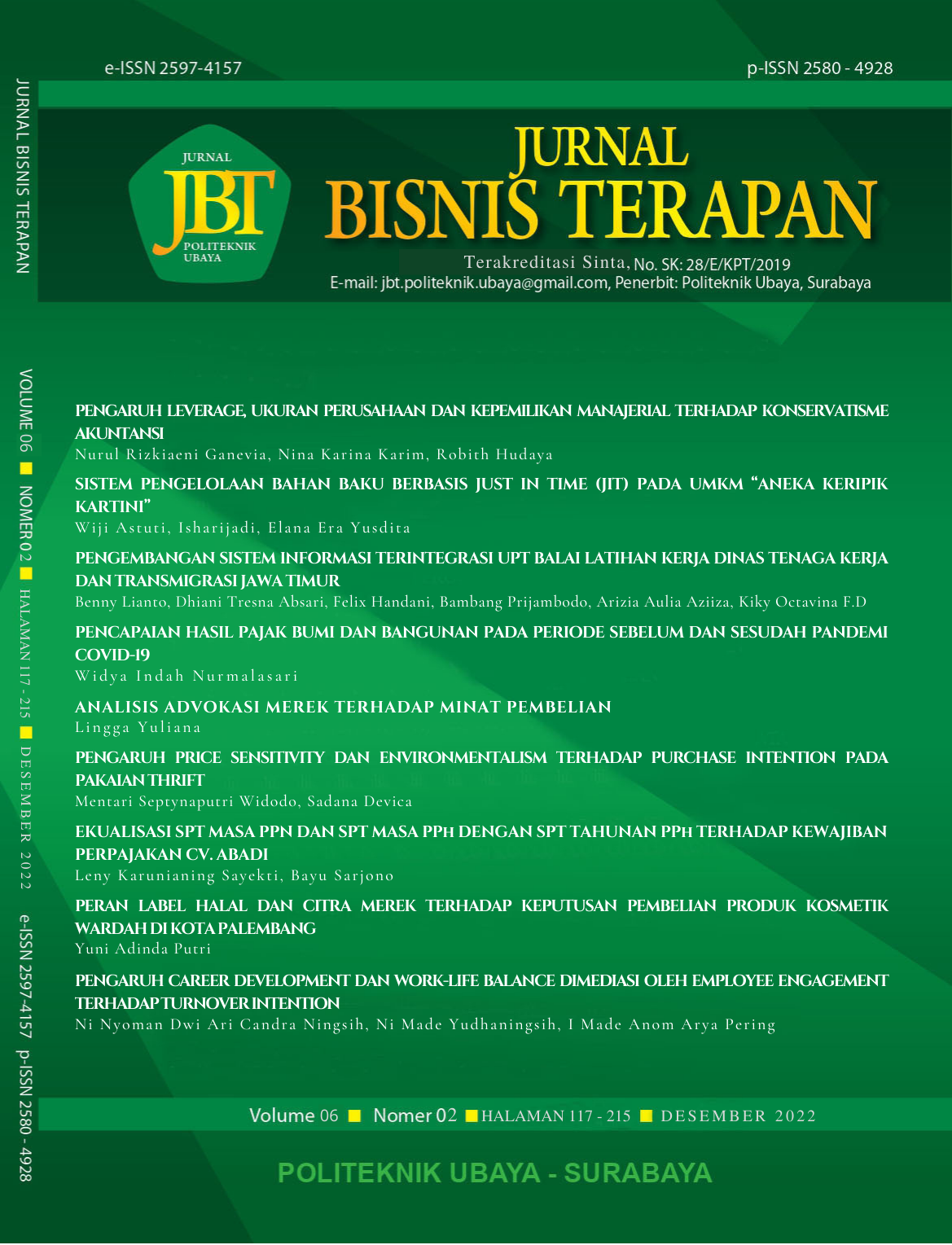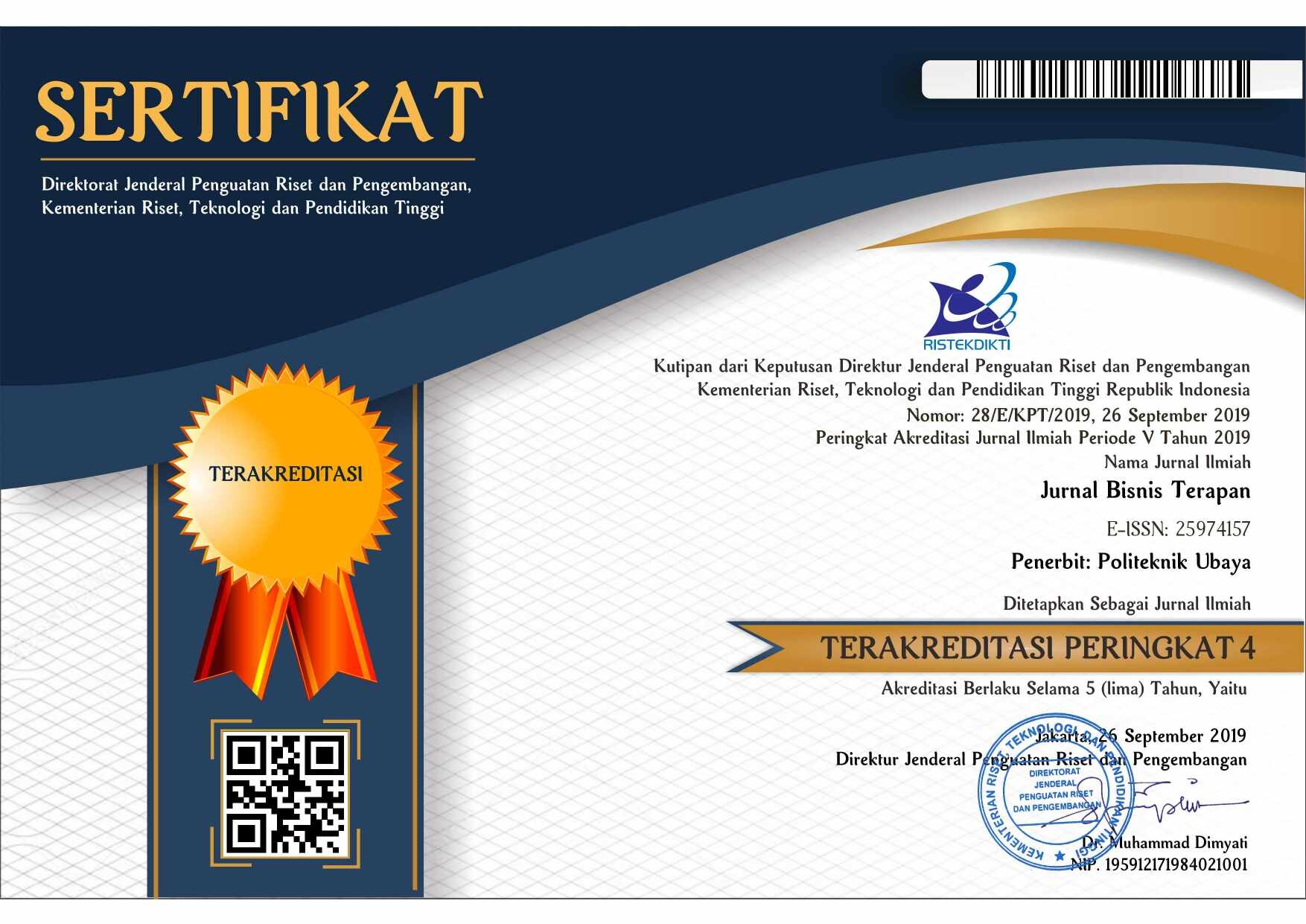PENGARUH PRICE SENSITIVITY DAN ENVIRONMENTALISM TERHADAP PURCHASE INTENTION PADA PAKAIAN THRIFT
 Abstract Views:
955 times
Abstract Views:
955 times
 PDF Downloads:
873 times
PDF Downloads:
873 times
Abstract
Abstract
A person's need for fashion is also always growing, with the need for fashion, now the trend of thrift clothes is also developing, which is known as thrifting. Thrifting is an activity to buy used goods, especially clothing with the aim of helping to reduce environmental pollution produced by fast fashion activities. Indonesian consumers' interest in these thrift goods is increasing over time. Where the data shows that the level of consumption of thrift clothing has increased by 21 percent in the last three years. Based on several previous studies, there are several things that affect a person's purchase intention in buying thrift goods. Among them are environmentalism and price sensitivity.The aim of this study is to investigate the unique characteristics of these consumers and offer a better understanding of the specific drivers of thrift product consumption. In particular, this study explores the reality (or lack thereof) of a number of assumptions regarding the consumption of thrift goods. Thisresearch was conducted on 106 students. Data were processed using confirmatory factor analysis (CFA) and regression analysis. Testing using the structural equation model (SEM) shows that price sensitivity has a significant effect on purchase intention, while a person's level of environmentalism is found to have no effect on purchase intention.
Downloads
References
Anglin, L. K., Stuenkel, J. K., & Lepisto, L. R. (1994). The effect of stress on price sensitivity and comparison shopping. ACR North American Advances.
Arbuthnot, J. (1977). The roles of attitudinal and personality variables in the prediction of environmental behavior and knowledge. Environment and behavior, 9(2), 217-232.
Banerjee, B., & McKeage, K. (1994). How green is my value: exploring the relationship between environmentalism and materialism. ACR North American Advances.
Cervellon, M. C., Carey, L., & Harms, T. (2012). Something old, something used: Determinants of women's purchase of vintage fashion vs second‐hand fashion. International Journal of Retail & Distribution Management.
Dachlan, U. (2014). Panduan lengkap structural equation modeling Tingkat Dasar. Semarang: Lentera Ilmu.
Evelina, L. W., & Wibisono, M. R. S. (2021). TREND MILENIAL MENGGUNAKAN SECOND BRANDED FASHION STREET WEAR SEBAGAI IDENTITAS DIRI. Jurnal Ilmu Komunikasi dan Bisnis, 6(2), 237-255.
Goldsmith, R. E., & Newell, S. J. (1997). Innovativeness and price sensitivity: managerial, theoretical and methodological issues. Journal of Product & Brand Management.
Gray, D. B., Borden, R. J., & Weigel, R. H. (1985). Ecological beliefs and behaviors: Assessment and change (Vol. 4). Praeger.
Grewal, D., Monroe, K. B., & Krishnan, R. (1998). The effects of price-comparison advertising on buyers’ perceptions of acquisition value, transaction value, and behavioral intentions. Journal of marketing, 62(2), 46-59.
Haraldsson, F., & Peric, S. (2017). Drivers and motivations for second-hand shopping: A study of second-hand consumers.
Indonesia, C. N. B. C. (2019). Gairah industri fashion Indonesia. CNBC Indonesia.
Kestenbaum, R. (2017). Fashion retailers have to adapt to deal with secondhand clothes sold online. Forbes. Available online: https://www. forbes. com/sites/richardkestenbaum/2017/04/11/fashion-retailers-haveto-adapt-to-deal-with-secondhand-clothes-sold-online.
Mishal, A., Dubey, R., Gupta, O. K., & Luo, Z. (2017). Dynamics of environmental consciousness and green purchase behaviour: an empirical study. International Journal of Climate Change Strategies and Management.
Morgan, L. R., & Birtwistle, G. (2009). An investigation of young fashion consumers' disposal habits. International journal of consumer studies, 33(2), 190-198.
Turner, M. L. (2020, March 30). Used Clothing Resale Is A Rising Opportunity For Retailers Large And Small. Retrieved September 1, 2020, from Forbes website.
Nugraha, R., Kusumawardani, K. A., & Octavianie, V. (2018). The influence of celebrity endorsement in Instagram towards customer behavior and purchase intention in healthy food diet business. FIRM Journal of Management Studies, 3(2).
Park, C. W., & Lessig, V. P. (1981). Familiarity and its impact on consumer decision biases and heuristics. Journal of consumer research, 8(2), 223-230.
Rezvani, S., Dehkordi, G. J., Rahman, M. S., Fouladivanda, F., Habibi, M., & Eghtebasi, S. (2012). A conceptual study on the country of origin effect on consumer purchase intention. Asian Social Science, 8(12), 205-215.
Setiawan, D. A., & Afrilinda, K. Determinants of Secondhand Clothes Repurchase Intention: Indonesian Consumer's Perspective.
Supranto, J. (2004).Analisis Multivariat Arti dan Representasi, PT Rineka Cipta: Jakarta.
Widayat. (2004).Metode Penelitian Pemasaran: Aplikasi Software SPSS,UMM Press: Malang.
Zeithaml, V. A. (1988). Consumer perceptions of price, quality, and value: a means-end model and synthesis of evidence. Journal of marketing, 52(3), 2-22.
Zelezny, L. C., & Schultz, P. W. (2000). Psychology of promoting environmentalism: Promoting environmentalism. Journal of social issues, 56(3), 365-371.


This work is licensed under a Creative Commons Attribution-NonCommercial-ShareAlike 4.0 International License.

Ciptaan disebarluaskan di bawah Lisensi Creative Commons Atribusi-NonKomersial-BerbagiSerupa 4.0 Internasional.
-
Articles published in Jurnal Bisnis Terapan are licensed under a Creative Commons Attribution-NonCommercial-ShareAlike 4.0 International (CC BY-NC-SA 4.0) license, which permits anyone to copy, transform, or redistribute articles for any lawful purpose in any medium, provided appropriate credit is given to the original author(s) and Jurnal Bisnis Terapan is recognized as its original publisher. A link to this license should also be provided. Any derivative work of an article published in Jurnal Bisnis Terapan must also be shared under the same (or compatible) license.
-
Both copyright and publishing rights on articles are retained by the respective author(s), without restrictions. Only a non-exclusive license is granted to Jurnal Bisnis Terapan to publish the article and identify itself as its original publisher.

 DOI:
DOI:






